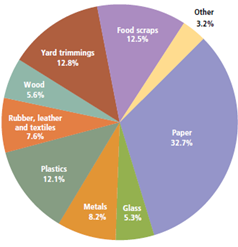So What's the Big Deal?
Many people wonder what is the big deal? We buy an item, use that item, and when we are done and that item has out used its usefulness, we throw it away. We never put much thought into where that item goes once it has left our home. The average person probably does not know where their trash goes and the effect that trash has on the environment. Adults would probably say that it goes to a landfill. Children would probably say that the trash just goes away on the garbage truck. However it is important to know that our trash is composed of many different types of materials. A person may be surprised if they could analyze the contents of what is in a typical bag of trash that is taken from someone's home. Typically there is food of all types from banana peels, apple cores, bones, coffee grounds and a myriad of other items directly related to food. This in and of itself is not too bad. But what about the styrofoam plate, plastic silverware and plastic cups used for a meal that are disposed of in the trash? These are items that do not decompose as easily and readily as food products. Now, let's throw in paper of all types, copy paper, newspaper, packaging of a product, batteries, broken toys, burned out light bulbs and a wide variety of other items. All of these items are sent away in the trash without a care or worry of the disposer. Mother Nature is beginning to make people take notice.
The United States Environmental Protection Agency (EPA) has collected data for more than 30 years about the generation of waste and the disposal of that waste. In 2007, the United States generated 254 million tons of waste. 1 The amount of waste per person that is generated is approximately 4.62 pounds per day. 2 This is an increase from 3.66 pounds per person in 1980. In almost 30 years, the amount of waste per person has increased by one pound. This is amazing that the average person is throwing away about 5 pounds of trash a day. In the course of one year, the average person is throwing away approximately 1,686 pounds! The Earth is saying, "No More!" The EPA did a breakdown of the 254 million tons of waste that were thrown away by the U.S. in 2007. The EPA reported that 32.7% of all waste was paper, 12.8% were yard trimmings, 12.5% were food scraps, 12.1% were plastics, 8.2% were metals, 7.6% were rubber, leather and textiles, 5.6% were wood, 5.3% were glass, and 3.2% was other. 3 A graphical representation better illustrates this. This graph comes courtesy of the Environmental Protection Agency's (EPA) Guide for Municipal Solid Waste Generation, Recycling, and Disposal in the United States: Facts and Figures for 2007.

So what does this mean to the average person? Why is this important? In the past 47 years, the amount of waste that each person generates has increased from 2.7 pounds per day to 4.62 per day. 4 If this trend continues, there will serious issues to contend with in the next 50 years as our population continues to rise. The best way to tackle this problem is to try to prevent the waste from being generated in the first place. It is essential to look at how we can reduce the amount of waste we generate, reuse items so that they are not discarded in the trash, and recycle objects that have been discarded.

Comments: